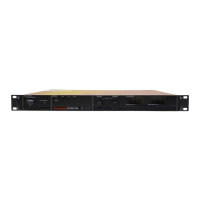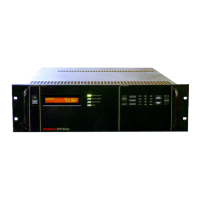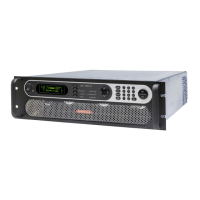Sorensen DCS Series 1kW and 1.2kW Supplies Theory of Operation
M362500-01 Rev K 3-5
OUTPUT RECTIFIER CIRCUIT AND OUTPUT FILTER
The DCS series uses two different configurations for the output rectifier. The 8V to 100V
models use a full wave center tap configuration while the 150 to 600V models employ a full
wave bridge. On 8V to 20V models, the output rectifiers are one piece power tap units mounted
on the rectifier heatsink with the secondary snubber components connected directly to the
rectifier terminals. The 33V to 600V models have their rectifier and snubber components on a
separate printed circuit board that is mounted on a rectifier heatsink. Capacitors C51-C53,
power inductor L3 and common mode inductor L4 form the main output filter on all models. On
8V to 100V models the secondary filter capacitors C401-C406 are on a separate PCB that is
mounted on the output bus bar assembly. On 150V to 600V models the secondary filter
capacitors C50, C50A, C50B, C50C, C48, C48B, C49, and C49B are mounted directly on the
A2 PCB. Resistor R145 is an output pre-load which allows the unit to operate under no load or
light load conditions (resistor R144A is a zero ohm jumper to short out R144 and connect R145
to the positive output on models from 8-300V). Resistor R144 is used in series with R145 only
on the 600V model as the output filter capacitors C106, C107 are used in series at this higher
voltage. Following is a description of the differences between models that describe the rectifier
arrangements for the models at differing voltages
• Models 8V through 20V
On these models diodes CR301 and CR302 rectify the output of power transformer T1.
Resistors R301, R303 and R304 and capacitors C301 and C302 form snubbers on the
secondary of T1 to limit switching transients while capacitors C305 and C306 are used
to provide bypassing on the positive output of the rectifier to chassis.
• Models 33V through 100V
On these models diodes D1 and D2 rectify the output of power transformer T1.
Resistors R2 and R3 and capacitors C3 and C4 form snubbers on the secondary of T1
to limit switching transients. Resistors R1 and R4 and capacitors C2 and C5 are used to
provide additional rectifier snubbing. C1 and C6 provide bypassing on the positive output
of the rectifier to chassis.
• Models 150V through 300V
On these models diodes CR301-CR304 form the rectifier bridge with resistors
R301-R304 and capacitors C301-C304 providing snubbing for the diodes. Resistor
R305 and capacitor C305 form the snubber on the secondary of T1. Capacitor C306
provides bypassing on the positive output of the bridge to chassis.
• Model 600V
On this model, series connected diodes CR300-CR307 form the rectifier bridge with
resistors R300-R307 and capacitors C300-C307 providing snubbing for the diodes.
Resistor R308 and R309 and capacitor C308 form the snubber on the secondary of
transformer T1. Capacitor C309 provides bypassing on the positive output of the bridge
to chassis.

